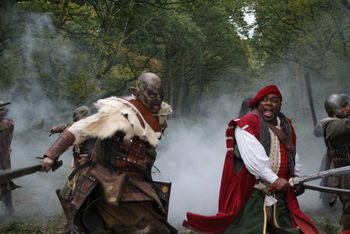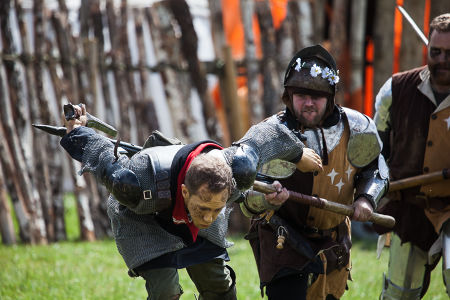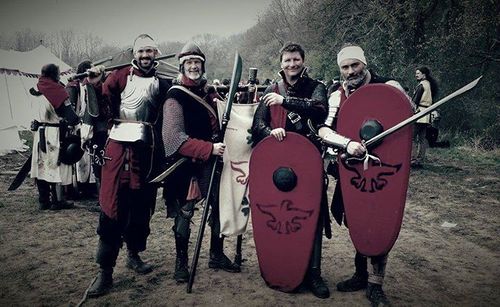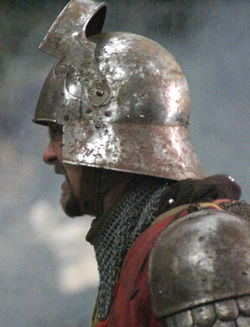Weapons & armour
(→Wands) |
(→Rods) |
||
| Line 72: | Line 72: | ||
===Rods=== | ===Rods=== | ||
*'''Must be between 18” long and 42” long''' | |||
A rod is 18” to 42” long. Wielded in one hand, a rod is popular with many magicians who take the battlefield because it can be combined with a shield or with another one-handed weapon (provided the magician possesses the skill to do so). Magical rods most commonly enhance battlefield incantations such as [[repel]] or [[swift heal]]. | A rod is 18” to 42” long. Wielded in one hand, a rod is popular with many magicians who take the battlefield because it can be combined with a shield or with another one-handed weapon (provided the magician possesses the skill to do so). Magical rods most commonly enhance battlefield incantations such as [[repel]] or [[swift heal]]. | ||
Revision as of 11:50, 31 January 2015
Weapons
- All weapons must be at least 8” (20 cm) long
- Some categories require you to use a set grip to fight with the weapon
There are five basic weapon categories in Empire. Any character can wield a one‑handed weapon but they must purchase the Weapon Master skill to use a larger weapon. Weapon categories are also important for enchantments and for use with the skills allowing heroic blows.
One-handed spears, pole-arms and pikes require you to use a set grip when fighting with the weapon. These grips are set for a combination of safety and play balance. You don’t have to carry the weapon like this when you are not fighting, but you must use the mandated grip throughout any fight where you use the weapon.
One-handed Weapons
- Must be between 8” long and 42” long
- Can call CLEAVE using a hero point and the Cleaving Strike skill
A one-handed weapon must be up to 42 inches long. If you expend a hero point then any one-handed weapon longer than 24" can be used to call CLEAVE provided you also have the relevant skill.
Flails up to 42” long are included in this category and can be used by any character. Larger flails are covered by the rules for two-handed weapons.
Two-handed weapons
- Must be between 42” long and 60” long
- Can call CLEAVE using a hero point and the Cleaving Strike skill
- Can call SHATTER using a hero point and the Shattering Blow skill
- You must hold the weapon in both hands
A two-handed weapon must be between 42 inches and 60 inches in length. If you expend a hero point then any two-handed weapon can be used to call CLEAVE or SHATTER provided you also have the relevant skill.
The phys-rep for a two-handed weapon can be any suitable phys-rep such as a great sword, dane axe or similar. You must hold the weapon in both hands during combat.
Pole-arms
- Must be between 60” long and 84” long
- Can have a thrust-safe tip
- Can call CLEAVE using a hero point and the Cleaving Strike skill
- Can call STRIKEDOWN using a hero point and the Mighty Strikedown skill
- You must hold the weapon in both hands with at least 18” separating them
A pole-arm must be between 60" and 84" in length. You can always swing a pole-arm at any enemy but you may also thrust with the weapon if it has a thrust safe tip. If you expend a hero point then any pole-arm can be used to call CLEAVE or STRIKEDOWN provided you also have the relevant skill.
The phys-rep for a pole-arm should be any suitable phys-rep for a pole-arm designed for swinging or thrusting at an enemy such as a bardiche, halberd or bill. You must hold the weapon in both hands at all times and keep at least 18 inches separation between your hands during combat.
One-handed Spear
- Must be between 60" long and 84" long
- Must have a thrust-safe tip
- You must only thrust with a one-handed spear, you cannot swing it
- Can call CLEAVE using a hero point and the Cleaving Strike skill
- You must hold the weapon within 6" of the centre of the haft
A one-handed spear must be between 60" long and 84" long. If you expend a hero point then any one-handed weapon can be used to call CLEAVE provided you also have the relevant skill.
The phys-rep for a one-handed spear should be any suitable phys-rep for a spear designed for thrusting at an enemy. You must hold the weapon within 6" of the centre of the haft during combat.
Pike
- Must be between 84” long and 108” long
- Must have a thrust-safe tip
- You must only thrust with a pike, you cannot swing it
- You must hold the weapon in both hands with at least 18” separating them
A pike is any pole-arm between 7 foot and 9 foot in length. It must have a thrust safe tip. You may only thrust using a pike, you may not swing any weapon that is over seven foot in length. A pike is too heavy and cumbersome to be used to make heroic calls.
The phys-rep for a pike should be any suitable phys-rep for a long pole-arm designed for thrusting at an enemy. You must hold the weapon in both hands at all times and have at least 18” separation between your hands during combat.
Implements
- Offensive spells can only be delivered using an implement
- Must be a safe phys-rep of a wand, rod or staff
- Should not look like a weapon
An implement is a magical tool that allows a magician to deliver an offensive spell. All offensive spells require an implement to be used. You cannot use an implement to cast a regular spell such as mend or heal.
All implements must be weapon safe phys-reps. They may appear to be made of any material, and should be decorated and shaped to make it as clear as possible that they are magical implements and not weapons.
Implements come in three broad classifications; wands, rods and staves. Any character with the magician skill can wield a wand or rod effectively, but the Battle Mage skill is needed to wield a staff.
A character can cause a point of damage with an implement, but they cannot be used with the heroic skills cleaving strike, shattering blow or mighty strikedown.
Although any magician may choose to use a wand or rod as an implement, some magical enchantments can only be placed on wands and some can only be placed on rods.
Wands
- Must be between 8” long and 18” long
A wand is 8” to 18” long. Magical wands usually enhance healing incantations such as restore limb or utility incantations such as mend
Rods
- Must be between 18” long and 42” long
A rod is 18” to 42” long. Wielded in one hand, a rod is popular with many magicians who take the battlefield because it can be combined with a shield or with another one-handed weapon (provided the magician possesses the skill to do so). Magical rods most commonly enhance battlefield incantations such as repel or swift heal.
Staff
A staff is 42” to 84” long. It must be wielded in two hands, but greatly extends the magicians reach for delivering implement incantations. Staves are popular with magicians of all backgrounds, but require the Battle Mage skill to use in battle. Magic staves may enhance battlefield incantation or grant benefits to ritual casters.
A staff that is between 60" and 84" in length may have a thrust-safe tip. If it does then you may attack, and deliver spells and incantations by making an appropriately safe thrust to strike your target.
Bows
- You must have the Marskman skill to use a bow or crossbow
- You must hold the weapon in both hands to shoot
You may use a bow or crossbow. All missile weapons require both hands to shoot, and do IMPALE automatically, with no need to call the effect.
Shields
- Any character can use a buckler up to 15” (40 cm) in diameter
- Characters with the shield skill can use larger shields
- You can push with a shield, but you cannot shield barge another character
Any character can use a buckler, a small shield up to 15 inches in diameter. If you have the shield skill then you can use a larger shield. The maximum dimensions for a shield are based on the shape, listed in the table below.
| Shield Type | Max Dimensions |
|---|---|
| Buckler | 15" (40cm) diameter |
| Round shield | 40" (1m) diameter |
| Tower shield | 40" by 24" (1m by 60cm) |
| Kite/Heater shield | 48" by 24" (1.2m by 60cm) |
If you are standing still or walking slowly then you may hold a shield out and push with it. You are not allowed to shield barge other characters; you must not run, shield first, into another character for safety reasons.
Armour
- All characters can wear armour
- Armour that covers the torso and another location provides extra global hits
- Some armour protects from CLEAVE or IMPALE
- Magicians cannot cast spells while wearing armour
Armour protects the wearer by increasing their global hits if it covers the majority of the torso and at least one other location. Valid locations are the head (with a helm), the arms and the legs, or you may cover half of your arms and legs.
E.g. A mail vest covers your torso but does not cover another location. If you wear it with a helm them it would count. A full-length mail hauberk covers the torso, thighs and upper arms so it would always count.
Medium armour protects a character against CLEAVE, while heavy armour protects them against CLEAVE and IMPALE. You are only protected if the blow strikes the armour phys-rep; if it hits an unprotected part of the body then you are affected normally. Your armour continues to protect you in this way even if the hits it provides have been lost.
Any character can wear armour, but magicians cannot cast spells or perform rituals while wearing armour.
To count as armour, the phys-rep must be a phys-rep of a suit of armour. A leather coat or biker-jacket does not count as armour and is not appropriate costume for the Empire setting. Leather armour may count as light or medium armour depending on the thickness; adding studs or rivets does not make it count as heavy armour.
Armour does not provide separate armour hits, it protects you by increasing your global hits. Armour is not repaired separately. Whenever you are healed back to full hits all lost hits are regained.
Wearing more than one type of armour does not grant any additional hits.
Light Armour
- Padded cloth or thin leather armour (between 1.5mm and 3mm).
- Provides 2 extra hits only.
Any armour made of padded cloth such as a gambeson or light or thin leather such as a thin leather hauberk provides the wearer with 2 additional hits. It does not provide any additional protection against heroic blows.
Any cloth or leather that is less than 1.5mm thick counts as clothing, it does not count as armour at all. Costume made from foam or karrimat does not count as armour.
Medium Armour
- Thick leather or any light weight armour materials, such as polyurethane or aluminium.
- Provides 3 extra hits and protects against CLEAVE.
Thick leather armour (the majority of the armour is more than 3mm thick) or any armour made from a light weight material such as polyurethane (e.g. Norton Armour), aluminium, or mixed neoprene and steel provides the wearer with 3 extra hits. Light mail, such as modern ring mesh (butcher's mail) or mail with an open weave (sometimes called "ring mail"), counts as medium armour.
If the wearer is hit by a CLEAVE heroic blow that strikes a piece of medium armour rather than directly hitting the wearer then the target loses one hit but does not take any additional effects.
Heavy Armour
- Armour made from steel or a similar weight metal
- If there are plates used they must be at least 1mm thick
- Butchers mail and ring mail are not included as heavy armour, regardless of the materials used
- Provides 4 extra hits and protects against CLEAVE and IMPALE
Any armour that is primarily made from steel provides the wearer with 4 extra hits. Other base metals that weigh the same such as brass would also count, but aluminium and titanium armour counts as medium.
If the wearer is hit by a CLEAVE or IMPALE heroic blow, or a PARALYSE call, that strikes a piece of heavy armour rather than directly hitting the wearer then the target loses one hit but does not take any additional effects.
Mage Armour
- You must have the battle mage skill to wear mage armour
- Must cover at least 3 locations including one of the chest, shoulders or waist
- Providers 2 extra hits only
- Does not protect against CLEAVE or IMPALE calls
Mage armour is a magical talisman that protects you against harm but allows you to cast spells and perform rituals. The talisman is made up of several pieces fitted to the wearer's body to protect them. The parts of the talisman superficially resemble pieces of armour, but armour that is ornate and ceremonial rather than practical. They are often decorated with runes, crystals, gems or other magical accoutrements and it is clear that the armour protects the wearer through magic rather than by physically deflecting blows.
Mage armour provides the wearer with two additional hits. Mage armour does not protect against CLEAVE or IMPALE. To qualify the talisman must include three of the following items including at least one of the first three items on the list:
- Pauldrons (shoulders)
- Pectorals (upper chest)
- Hero Belt (waist)
- Circlet (head)
- Vambraces (wrists)
- Gorget (neck)
- Greaves (lower legs)
The items must be substantial and cover a significant portion of the area but it is possible to use a single pauldron, greave or vambrace if appropriate for the costume.
You must have the Battle Mage skill to wear and use mage armour. Although mage armour is magical in nature, any character with the battle mage skill is assumed to have access to a suit of mage armour, in the same way a warrior has access to a suit of mundane armour.
Mage armour can be made out of any real world material, provided you try to make as clear as possible that your character is wearing magical protection and not mundane armour.
Further Reading
- Combat
- Calls
- Weapons & Armour
- Game Items
- Stealing
- Roleplaying Effects
- Rules FAQ
- Rules Summary in A5 and A4




